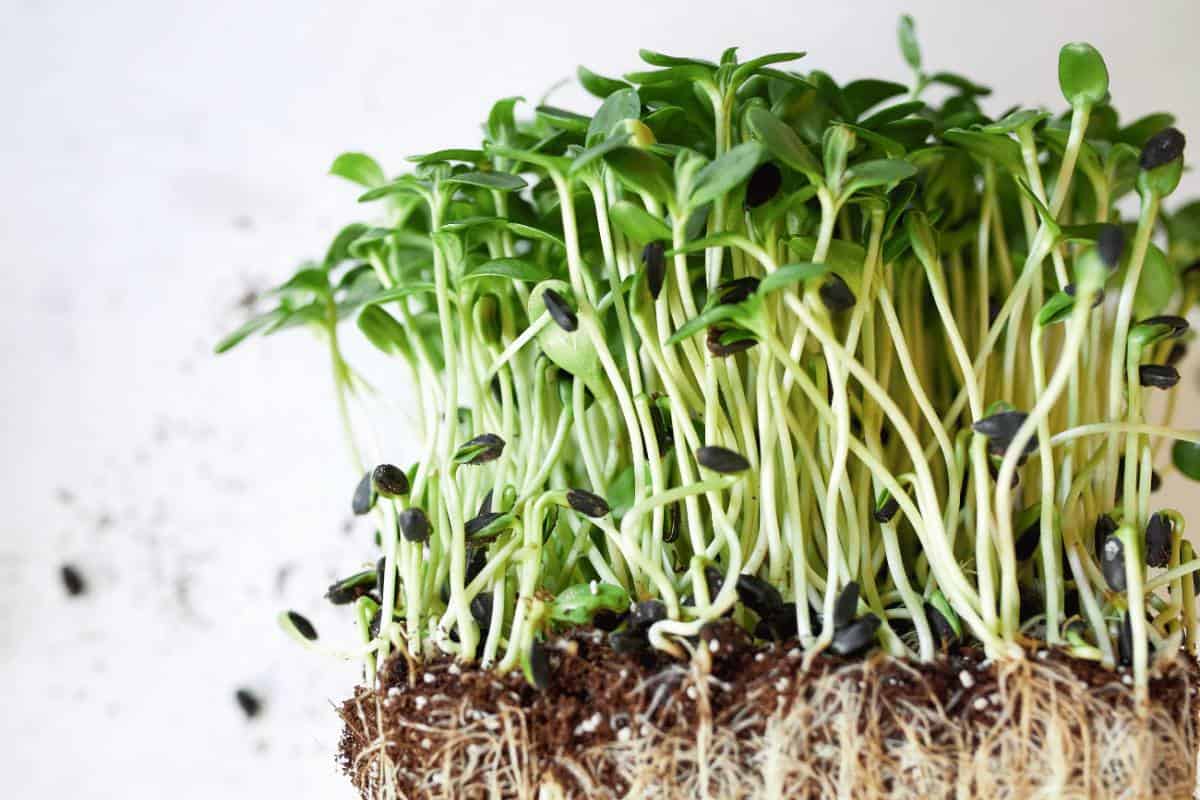Microgreens are having a moment, and for good reason – these teeny, tiny mini greens pack a serious nutritional punch, and many varieties boast big flavors despite their small size.
Here at Sweet New Roots, our family is on a bi-weekly schedule for home delivery of hydroponic microgreens, including sunflower shoots and hyper-nutritious broccoli sprouts. I love to add these greens to smoothies, soups and salads.
The following list of microgreens covers some of the most common varieties you may have heard about. This index of more than 70 types of microgreens is broken down into 3 primary categories:
- Full list in alphabetical order
- Organized by group: edible microgreens, shoots and sprouts
- Not safe to eat
The terms ‘complete’ and ‘comprehensive’ are used loosely. It’s challenging to track precisely the numerous microgreen varieties due in part to ongoing cultivation, crossbreeding and experimentation. One thing we know for certain: adding mini greens to your diet is a wonderful way to boost your health and brighten your plate (and your palate)!
Full List of Microgreens, Shoots and Sprouts
- Adzuki
- Alfalfa
- Amaranth
- Anise
- Arugula
- Asparagus
- Bamboo
- Barley
- Basil
- Beet
- Borage
- Broccoli
- Brussels sprouts
- Buckwheat
- Cabbage
- Carrot
- Cauliflower
- Celery
- Chard
- Chia
- Chicory
- Chive
- Coriander (Cilantro)
- Clover
- Collard
- Corn
- Cucumber
- Dandelion
- Dill
- Endive
- Fava
- Fennel
- Fenugreek
- Flaxseed
- Garbanzo
- Garlic
- Hemp
- Kale
- Leek
- Lemon balm
- Lemongrass
- Lentil
- Lettuce
- Marigold
- Marjoram
- Mint
- Millet
- Mizuna
- Mung bean
- Mustard
- Orach
- Oregano
- Parsley
- Pea
- Pumpkin
- Purslane
- Quinoa
- Radish
- Rutabaga
- Sage
- Sambuca (Elderberry)
- Sesame
- Scallion
- Soy
- Spinach
- Sunflower
- Tangerine
- Tarragon
- Thyme
- Turnip
- Wasabi
- Watercress
- Wheatgrass

Microgreens List Organized by Group
Mini greens are young, nutrient-rich versions of their full-sized plant varieties and the terms are often used interchangeably. However, there are some differences that are generally reflective of their unique flavor intensity – often based on their growth stage at harvest – as well as their culinary uses.
Below is a breakdown commonly used to differentiate baby greens at their most desirable stages of growth and harvest – from sprout, to shoot, to microgreen.
Types of Sprouts
Sprouts are described as the newly germinated beans, grains or seeds that have been grown in water for a very short period of time – an average of 2 to 7 days – and are harvested just as the seed has sprouted and before the first leaves appear. Sprouts are harvested at the earliest stages of growth.
- Adzuki
- Alfalfa
- Anise
- Barley
- Borage
- Buckwheat
- Chia
- Fava
- Fennel
- Fenugreek
- Flaxseed
- Garbanzo
- Hemp
- Lentil
- Marjoram
- Millet
- Mung bean
- Pumpkin
- Purslane
- Quinoa
- Sambuca (Elderberry)
- Soy
- Tangerine
Types of Shoots
The term ‘shoots’ refers to the tender stems and leaves of plants that have matured past the typical microgreen and sprout phase, but are still very young. In other words, they’ve already sprouted but are not yet fully developed. Shoots are harvested after sprouts but before the plants reach “microgreen” status.
- Asparagus
- Bamboo
- Broccoli
- Garlic
- Leek
- Sunflower

Microgreens List
Microgreens are the young versions of herbs, vegetables and greens typically harvested when the earliest leaves begin to develop – so, before the plant matures, but harvest a little later than sprouts and shoots. Many types of microgreens are enjoyed for the high-density nutrients as well as their bright and intense flavor profiles. Common varieties of microgreens include arugula, basil, radish and wheatgrass.
- Amaranth
- Arugula
- Basil
- Beet
- Brussels sprouts
- Buckwheat
- Cabbage
- Carrot
- Cauliflower
- Celery
- Chard
- Chicory
- Chive
- Coriander (Cilantro)
- Clover
- Collard
- Corn
- Cucumber
- Dandelion
- Endive
- Kale
- Lettuce
- Marigold
- Mizuna
- Mustard
- Orach
- Oregano
- Parsley
- Radish
- Rutabaga
- Sage
- Sesame
- Scallion
- Spinach
- Tarragon
- Thyme
- Turnip
- Wasabi
- Watercress
- Wheatgrass
List of Microgreens to Avoid
It’s advisable that young sprouts, shoots and microgreens from the nightshade family are avoided as they are considered toxic and not safe to eat. It’s advisable to consume nightshades that are fully grown and no longer in microgreen form (1).
These include:
- Eggplant
- Bell pepper
- White potato
- Tomatillo
- Tomato
Furthermore, as a general rule, it’s important to practice food safety guidelines when consuming baby greens, just as you would for any other fully grown greens and vegetables, which are capable of carrying foodborne disease including listeria, e. Coli and salmonella (2).
Sources Cited in This Article:
- Illinois Extension: Small, But Mighty Microgreens are Easy to Grow Indoors
- Healthline: Microgreens: All You Ever Wanted to Know
*Medical Disclaimer: All content and information on this website is for informational purposes only and does not constitute medical advice. Always consult a medical professional or healthcare provider if you are seeking medical advice, diagnosis or treatment. Sweet New Roots, LLC is not liable for risks or issues associated with using or acting upon the information on this website.

